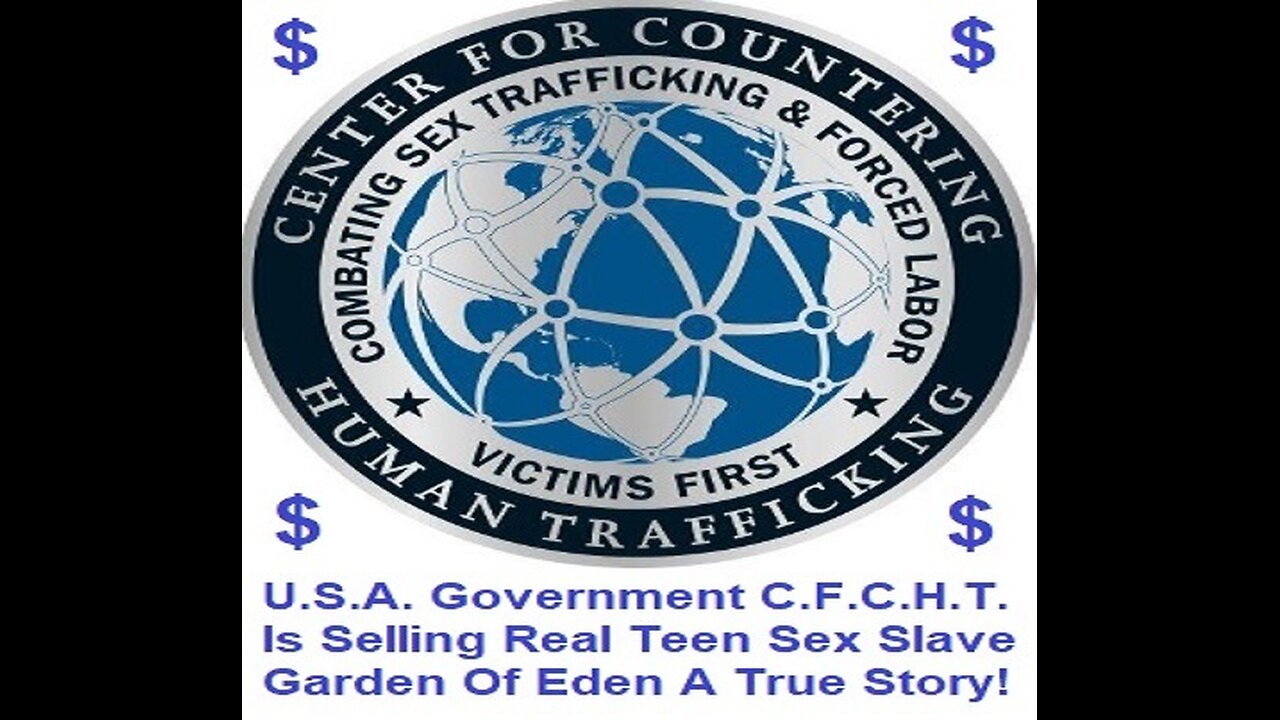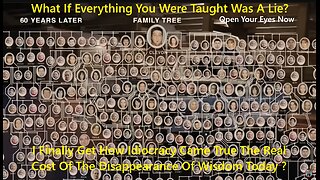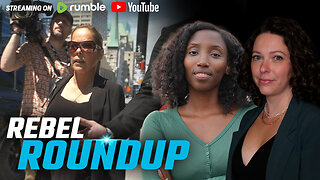Premium Only Content

U.S.A. Government C.F.C.H.T. Is Selling Real Sex Slave Garden Of Eden A True Story
Department Of Homeland Security Strategy To Sell And Combat Its Own Human Sex Trafficking In The Movie Eden 2012. The Importation Of Goods Produced With Forced Labor, And Child Sexual Exploitation. DHS-CIA-DOJ-FBI-Etc. Secrets Sex Multi-Billion Dollar Human Trafficking Industry. All Child Molesters Are Hebephiles-Ephebophiles-Pedophiles Who Rule the World And For Greater Good You Will Never Trust U.S.A. Government C.F.C.H.T. Again ?
Sex tourism is a global phenomenon, and America is a trending destination for tourists looking to exploit young girls. Is this your first time hearing about sex tourism? If so, buckle up. It’s evil and tearing its way through vulnerable lives. Sex tourism is exactly what it sounds like. “Tourists” go-to destinations to have sex with girls. Young girls. Where there is demand, there are services provided, and girls are paying the price.
“Child sex tourism is a serious problem, with child sex tourists arriving mostly from the United States and Europe.”
You might be wondering who takes “sex tours.” You would be surprised by the answer. Every trafficked girl we have interviewed for the last 5 years has told us her number one client base is North Americans. As we’ve walked around the cities and researched the issue, this continues to prove true.
These are not people you would look at and label “predator.” These are people you would see in your middle-class, suburban neighborhood. What some would label a “America issue” is actually knocking at our front door.
In America, the younger a girl is, the more a client will pay. Traffickers target and begin grooming early. In a region riddled with teenage, single-parent households, America is a perfect breeding ground for traffickers. As is true all over the world, poverty is a powerful force fueling human trafficking.
Traffickers target girls who have needs they can’t meet on their own. They promise them help, and in bait and switch, hand them a life of slavery. When a single teen mom has no way to pay for food, diapers or a home for her child, traffickers step in.
Some would say that Sex Tourism has nothing to do with Human Trafficking. But that perspective is incredibly misguided. Under the guise of legal prostitution, there are countless trafficked women and children in America exploited daily.
Once you see it, you cannot un-see it.
https://s3.documentcloud.org/documents/21165424/epstein-flight-logs-released-in-usa-vs-maxwell.pdf
Sex tourism. Human trafficking. The sexual exploitation of children. Pick a name. It’s everywhere and it’s destroying lives. According to the Centers for Disease Control and Prevention
“Sex tourism supports human trafficking (slavery), one of the largest criminal industries in the world…Millions of children around the world are victims of commercial sexual exploitation.
Children abused by sex tourists suffer not only sexual abuse but also physical, emotional, and psychological abuse, as well as poverty and homelessness.
They suffer from health problems including addiction, malnourishment, injuries, STIs and emotional trauma.”
There are 40.3 million slaves worldwide and at least 53 different countries reporting concerns of child sex tourism, with several of those falling within America. The need to act and speak up against this horrific practice is incredibly urgent.
This is why we are building a rescue and rehabilitation home to serve these girls. The America rescue facility will offer residential care to trafficked girls. This home will help these girls find hope through group and individual counseling. And ultimately, it will educate and equip them with marketable skills as they build towards healing and a future.
In the midst of a terribly dark and evil trend such as sex tourism, we still see hope on the horizon. The reality is, you may be the only voice these girls have. Will you join us in the fight to end human trafficking?
DHS Government C.F.C.H.T. Center for Countering Human Trafficking And Sex Slave Sale And All Sales Are Final Policy is a notice displayed on a company's website that states that customers cannot return certain items for a refund. This policy is commonly used when selling products that are harder to resell, such as custom items, perishable goods, and clearance stock. However, it does not mean that the customer has the right to return the item if they change their mind or find it does not fit their purposes. If the item is broken, there would be a breach of warranty, and the store would have an obligation to repair, replace, or give a refund. Some merchants may accept returns and issue refunds if damage occurs in shipping or if a product was given as a gift and the recipient prefers something else. Every business is unique, so there is no right answer as to whether an All Sales Are Final Policy is right for you.
Human trafficking uses force, fraud, and/or coercion for the purpose of sexual exploitation or forced labor. Contrary to popular belief, as defined by law, human trafficking does not necessarily involve moving people across borders. There are many millions of victims worldwide, with estimates of 600,000 to 800,000 people being trafficked in the U.S.A. In the movie Eden 2012, a young Korean-American girl, is abducted near her home and forced into prostitution by a domestic human and drug trafficking ring. Throughout the two years she is held, Eden reluctantly ensures her own survival by carving out power and influence within the very organization that has imprisoned her. Inspired by a harrowing true story, Eden peers into the darkest corners of America and attempts to discover the humanity within.
Sex tourism is a multibillion-dollar global sex tourism industry that victimizes approximately 2 million children around the world. Extraterritorial sexual exploitation of children is the act of traveling to a foreign country and engaging in sexual activity with a child in that country. According to the International Labour Organization (ILO), 1.8 million children were forced into prostitution and pornography in the year 2000, and it is estimated that more than US$ 25 billion are obtained through child prostitution every year.
Sex Trafficking: Victims of sex trafficking can be found working in massage parlors, brothels, strip clubs, escort services, and on the streets. They are often children or teenagers lured by false promises and, ultimately, forced into prostitution.
Minors: More than 50% of victims worldwide are estimated to be under the age of 18. Under U.S. law, any person under 18 involved in the commercial sex industry is considered a Human Trafficking victim.
Human Trafficking U.S.A. and Child Sex Tourism U.S.A. and Child Pornography! U.S.A. Pedophile's Lolita Pizza Express and Secret Trafficking and Child Sex Ring.
Recognizing the Signs of Human Trafficking
Person carries around keys for hotel rooms;
Person seems to be under the control of another person;
Person seems to be under continual surveillance;
Person has all contacts controlled and monitored;
Person doesn’t manage his/her own finances;
Person does not possess own ID or travel documentation and lies about age;
Person works excessively;
Person lives in poor or cramped conditions, such as multiple-occupation household;
Person is not paid or is paid very little;
Person lives with employer;
Person speaks little or none of the local language;
Person exhibits fear of being deported;
Person is seldom alone and is not allowed privacy;
Person has visible injuries such as scars, burns, lacerations, and bruises;
Person has injuries around head, including the face, nose, and mouth;
Person has untreated infections and sickness;
Person’s appearance betrays poor health and unsanitary living conditions;
Person exhibits drug use;
Person exhibits compliant, fearful, panicky behavior. More than 48 million people were estimated to be victims of modern slavery in 2022 – and one in four of those were children.
Social Justice and Families
1. Have a sense of how European ideals about family and society have been imposed on Indigenous peoples since colonization: assimilation by marriage, cultural genocide, residential schools, child welfare
2. Have a sense of early Canadian immigration policies (re: Chinese, South Asian, Japanese, foreign domestic workers) as explained in Das Gupta’s article.
Violence against women: From domestic abuse to structural violence
1. To be able to explain the strengths and limitations of the “gender lens” approach in dealing with violence: “When we look through a gender lens, the focus is mainly on male violence against women and children in intimate relationships” (129).
2. To be familiar with Vickers’ argument that violence is better understood in terms of unequal relations to power than when limited to a “gender lens” approach which leaves out significant variables like race, class, sexuality and structural considerations.
3. To have an understanding of how and why Aboriginal women in Canada are disproportionately victims of violence.
ntroducing Human Rights and Structural Violence
1. to understand the concept of “structural violence”
2. to have a sense of the “accessibility gap”
3. to establish a clear connection between structural violence and poverty
4. to have a sense of how gender and poverty expose certain people to particular risks
(think of Chouchou and Acephie)
5. to have an understanding of 4 of the 6 factors that Farmer suggests are necessary in analyzing and predicting violence and suffering.
Fixing Sex / Sexing Bodies
1. to be able to define the “one sex model”
2. to have a critical understanding of the claim that common or statistically “normal” characteristics are inherently good and natural
in relation to intersex bodies
3. to have some understanding of intersex people and the medically unnecessary surgeries that are performed on intersex infants, children and adults
4. to have some familiarity with the criteria used to determine whether or not to perform surgery on an intersex infant
5. to have some understanding of the role of testosterone in sex-testing female athletes to determine “athletic advantage”
Nature/Nurture: Sex/Gender Differences in Science and Pop Culture
1. to be able to give one concrete example of research into the biological foundation of sex differences that, on closer examination, yields contradictory results which overstate the meaning of those differences e.g. Simon Baron-Cohen and the infant mobile / face recognition experiments.
2. to explain why scientific publishing and popular culture tend to pick up on sex difference research that finds innate differences between girls and boys
3. to recognize the ways in which the gendering of toys and sex-segregated schools are, arguably, examples of “gender apartheid”
4. to have a basic understanding of current arguments relating to “neuroplasticity” and gender differences.
What’s in a label? The gender politics of global production
1. to have a general understanding of working conditions and workers in free trade zones and in garment factories generally, including: hours of work; health of workers; age of workers; working conditions; and the preference for young, women workers
2. to comprehend how trade liberalization (“free trade”), as well as social, economic and political forces, all play significant roles in escalating violence and femicide in Ciudad-Juarez
3. to be able to define “the race to the bottom”
4. to have an understanding of what maquiladoras are
5. to have an understanding of the dangers of working in these factories and the relative benefits that can be gained from working in them (for the latter part, think of the improvements in Minu and Shumi’s lives).
Global Politics: Women, tourism and trafficking
1. to develop an understanding of the roles that power, privilege and poverty play in travel and tourism
2. to have a sense of how vulnerable tourism is as a primary income generator for a country
3. to make connections between single, White women’s “adventures” in colonial territories, the transformation of Victorian ideas of femininity, and European women’s roles in furthering British imperialism
4. to be able to define debt bondage.
Canadian immigration policies treated non-European immigrants differently from each other (i.e. Chinese, South Asian, Japanese, foreign domestic workers). What kinds of work did the non-European immigrants do once they were admitted into Canada? According to Das Gupta how and why were non-White immigrants and families treated differently than White European settlers?
What are the maquiladoras, who owns and maintains them, and which country primarily manufactures in them? Explain who tends to do this factory work and why employers prefer to hire these people. Identify and explain two social, economic or political factors that are contributing to the violence in Ciudad-Juarez. How are family members organizing against the violence and what is happening to men who pursue justice for the missing and murdered women?
Objectives and goals:
1. to develop an understanding of the roles that power, privilege and poverty play in travel and tourism (example: the all-inclusive resort)
2. to have a sense of how vulnerable tourism is as a primary income generator for a country
3. to make connections between single, White women’s “adventures” in colonial territories, the transformation of Victorian ideas of femininity, and European women’s roles in furthering British imperialism
4. to have an understanding of debt bondage
5. to have a growing familiarity with the phenomena of sex tourism and so-called “romance tourism”
These readings are intended to take a look at how some privileged women and men get to travel while others cannot afford to travel and may end up serving those who can. This is to get us thinking about how people are connected on a transnational or global level where sometimes one person’s privilege and pleasure comes at the expense of another person’s disadvantaged position. This is most extreme and obvious in the case of sex tourism, but is arguably true of many forms of travel and tourism.
Often the argument is made that those of us who can afford to travel are “helping” the people in the country that we are visiting.
Jamaica Kincaid reminds us that “Most [people] in the world cannot go anywhere… They are too poor to escape the reality of their lives; and they are too poor to live properly in the place where they live, which is the very place you, the tourist, want to go…” While people who lived in Thailand, for example, were dealing with the “reality of their lives,” and generally couldn’t afford to escape, others travelled there to enjoy themselves and relax.
The tourist does not need to worry about local problems, and as Kincaid says, “That the native does not like the tourist is not hard to explain.”
Many Canadians travel to all-inclusive resorts and the readings for today are pointing us to think about the power dynamics inherent in tourism. We might ask what is included and who / what is excluded in an all-inclusive resort?
Often the tourists’ fantasy of leisure, safety and fun is premised on: others’ low wages, especially women; these men and women’s inability to travel as a result of their low wages; their exclusion from spaces within their own countries; and even their poverty. Often one person’s ability to travel is premised directly on another person’s poverty.
Cynthia Enloe points out that travel has been gendered in the sense that in many societies being feminine has been defined as sticking close to home. Masculinity, in contrast has been the passport to travel and men are often seen as being truly manly only once they move away from home and strike out on their own. Women who travel are often transgressing against these gender norms.
Enloe describes the history of travel by discussing White European and North American women’s “adventures” in colonial territories. White women travelling abroad was highly unusual and these “adventurers” were simultaneously transforming Victorian ideas about femininity by leaving the domestic sphere, while their travels were used to further the cause of British imperialism. Can anyone remember what these women did to promote colonialism and imperialism?
Enloe writes on page 391, that “the stay at home listeners would develop a sense of imperial pride as they heard another woman describe her travels among their empire’s more ‘exotic’ peoples. And they could expand their knowledge of the world without risking loss of that feminine respectability which enabled them to feel superior to colonized women. Their imperial curiosity, in turn, helped the [white women adventurers] finance [their] breaking of gendered conventions.”
In selling these fantasies of travel, you may have noticed that women are featured quite prominently in tourism ads.
Not only is travel gendered, but tourism advertising often uses women’s bodies to entice the would-be traveler. The copy in this advertisement reads in part, “Women, especially women of Montego Bay, have always helped make our land desirable.” They go on to say that many inns are run by women who will “pamper” you and act as “mistresses.”
These tourism ads are often about selling a tourist destination as seemingly having a “simpler,” more natural way of life that tourists believe that they do not have access to where they are from. Often these ads seem to suggest that the local women are somehow more available and inviting to the tourist than perhaps women in their own country.
In the same way as many travellers justify travelling to poor countries by saying that the locals “need” the money, sex tourists may also have similar ideas that they are “doing a favour” for people who need the money.
In the second article about prostitution in Thailand, Kevin Bale explains “debt bondage.” What is debt bondage?
How do you get out of debt bondage?
Why do poor families agree to sell their daughters?
What else stood out for you in that article?
How might the Western gender norm of the “respectable” White middle-class woman fit with female sex tourism or romance tourism?
What are the gender, race and class implications of “romance” tourism?
As tourists we often can’t see our pleasure as a product of power where our leisure is often highly dependent on another’s labour and poverty. In reaction to the notion that tourism creates more equality, Cynthia Enloe makes the argument that travel and tourism often actually prop up and maintain inequalities of gender, race, class and nation.
Note: Video is disturbing, especially the section on the casas
Screening: Hope in Heaven, DVD can be found in the Nipissing Education Library Call # TEMP 1476. 43 minutes.
What’s in a label? The gender politics of global production
Objectives and goals:
1. to have an understanding of working conditions and workers in free trade zones and in garment factories generally, including: hours of work; health of workers; age of workers; working conditions; and the preference for young, women workers
2. to comprehend how trade liberalization (“free trade”), as well as social, economic and political forces, all play significant roles in escalating violence in Ciudad-Juarez
3. to have a growing understanding of globalization, free trade zones, manufacturing and “the race to the bottom”
4. to have a growing understanding of what maquiladoras are
5. to have a growing sense of how people organize and resist violence, exploitive working conditions and corruption
6. to have a growing understanding of the dangers of working in these factories and the relative benefits that can be gained from working in them.
Let’s start by thinking a bit about our own clothing.
When we check clothes for tags what are we looking for?
What does the label actually tell you?
What else might we want to know that’s not on the label?
We need to think about what the labels don’t tell us, and what we are content not to know.
Today’s readings are concerned with the garment / clothing industry, but we could just as easily ask these questions of any other area of production – food, car manufacturing, children’s toys, computers, and so on.
Dangerous working conditions:
http://www.economist.com/blogs/banyan/2012/12/garment-factory-fires
http://www.cbc.ca/news/world/story/2012/11/25/bangladesh-garment-factory-fire.html
What is a global factory?
Examples: The Gap and Apple
Aren’t these factory jobs “better than nothing”?
How is it that labour is so cheap in “developing” countries?
Through trade agreements, like the North American Free Trade Agreement (NAFTA), global factories are facilitated through reduced tariffs and production infrastructure like Free Trade Zones.
What is “the race to the bottom”?
Most famous of the Free Trade Zones are the Mexican Maquiladoras and the Border Industrialization Program. Maquiladoras were introduced in the mid 1960s to industrialize the border between Mexico and the US. Who owns the maquiladoras?
Who tends to work in maquiladoras?
Why are these particular workers chosen over others?
In some factories, women are routinely given pregnancy tests. Why is that?
Keeping consumers and workers disconnected from each other is partly the job of marketing, and it is an important feature of branding.
Branding provides us with a whole set of associations with the product that don’t have anything to do with their materiality. Materiality refers here to how and where products are made, by whom, under what conditions.
Brands want to keep us focusing on the brand identity and not on the profits or working conditions.
The relationship between the labourer and the product is also disconnected. How so?
Ciudad-Juarez in Mexico is part of the Border Industrialization Program. The article and film outline a range of issues brought on by globalization, decreasing wages for workers post-Free Trade, low wages for police which leaves them ripe for corruption, no unions, laws against marijuana outside of Mexico, the sexualization of female workers in the maquiladoras, domestic violence as it relates to missing and murdered women, and also the range of men and women who are actively organizing against the exploitation and murder of women within “the global assembly line.”
Juarez is well known for “femicide;” the murder of women because they are women. More than 400 women have been murdered and another 4000 more have gone missing in Juarez since Canada, the United States and Mexico signed the North American Free Trade Agreement (NAFTA) in 1994.
In terms of gendered violence, I urge you to pay attention to how and why young women are being sexually assaulted, their bodies mutilated and then they are murdered, while men are being killed in gun crimes related to the drug trade. As Paul Farmer pointed out in his article on Haiti, we see gendered violence with poverty at its root.
What comes through in the video and not in the reading is that men who resisted violence against women were punished.
The number of murders in Juarez is declining rapidly from 3,115 in 2010 (an average of 8 a day), to 2,086 in 2011, to 750 in 2012. Journalists report that this is due to the end of a gang war, a new chief of police, a new mayor in 2010, and the addition of three new high schools and sports facilities:
http://latino.foxnews.com/latino/news/2012/10/02/mexico-murder-capital-world-sees-dip-in-killings/
http://www.cnn.com/2013/01/05/world/americas/mexico-juarez-killings-drop
But the murders continue: http://www.nytimes.com/2012/06/24/world/americas/wave-of-violence-swallows-more-women-in-juarez-mexico.html?pagewanted=all&_r=0
The readings and the film tie the murders of young women in Ciudad-Juarez, in part, to the maquiladoras.
Caution, the video is quite disturbing.
Screening: Hise, S. (Director). (2006). On the Edge: Femicide in Ciudad Juarez. Illegal Art (58 minutes).
Garwood writes, “The sexual violence in Juárez is… embedded in the various linkages between different types of social, economic, and political violence at various levels” (p. 21). What are some of the “social, economic and political” factors that are contributing to the violence in Ciudad Juarez?
Garwood writes, “Maquila workers are a diverse and heterogeneous group faced with complex and often contradictory ways in which the maquiladoras shape their lives. They gain from wages and new forms of independence, while suffering from multiple forms of exploitation” (p. 9). Describe how maquiladora workers gain independence but within highly exploitive conditions.
“Although the rapes and murders in Ciudad Juárez are widely denounced by politicians and police departments, they are done so in a way as to separate them from the daily violence many women endure in their own homes” (p. 13). “Focusing only on public acts of violence allows men who perpetrate gender violence at home (which still constitutes the majority of sexual violence) to distance their own actions from the sexual violence portrayed in the newspapers” (p. 13).
“The creation of ‘sexual subjects’ in the maquiladoras, Salzinger argues, is not distracting from production (as sexual harassment is often assumed to do), but is rather an integral part of the production process” (p. 15). How is sexualization “an integral part of the production process”?
How are women and men organizing in resistance to the murders?
Nature/Nurture: Sex/Gender Differences in Science and Pop Culture
Learning objectives:
1. to be able to give at least two concrete examples of research into the biological foundation of sex differences that, on closer examination, yields contradictory results which overstate the meaning of those differences e.g. Simon Baron-Cohen and the infant mobile / face recognition experiments; Louann Brizendine’s claims about the biological foundation for why there aren’t more women in politics.
2. to explain why scientific publishing and popular culture tend to pick up on sex difference research that finds innate differences between girls and boys
3. to recognize the ways in which the gendering and marketing of toys is, arguably, an example of “gender apartheid” (The Gender Trap part 1) and teaching different emotional, cognitive and motor skills to boys and girls
4. to have a basic understanding of current arguments relating to “neuroplasticity” and gender differences
5. to have a deepening understanding of the way scientific research is enculturated and reinforces cultural stereotypes about gender
6. to be able to explain three reasons why Kathy Witterick and David Stocker decided not to share Storm’s sex with more than 9 people in their lives
What would you say is the primary “issue” or question addressed in the first podcast, The Gender Trap part 1?
What does the podcast tell us about research that says that males and females have different brains?
What are the gender differences seen in babies’ behaviours that scientists now agree appear to be innate?
What are some of the critiques that Lise Eliot raised in relation to Simon Baron-Cohen’s infant mobile / face recognition experiments?
What are some of the critiques that have been leveled against research such as Louann Brizendine’s claims about the biological foundation for why there aren’t more women in politics?
According to the podcast, why are scientific journals more likely to publish research that finds innate differences between girls and boys than research that does not find a difference?
And according to the podcast, why does popular culture tend to pick up on these studies that find innate differences between boys and girls?
What is some of the research presented that asserts gender differences are learned?
Gendered toys and products: Start with some examples
The Hasbro video:
https://www.youtube.com/watch?v=qVgHrV9H-8k
What do you make of this activist video?
https://www.youtube.com/watch?v=rZn_lJoN6PI
What are the emotions that are cultivated through boys’ toys?
What are the emotions that are cultivated through girls’ toys?
What are the motor co-ordination skills that are cultivated through boys’ toys?
What are the motor co-ordination skills that are cultivated through girls’ toys?
What are the cognitive skills that are cultivated through boys’ toys?
What are the cognitive skills that are cultivated through girls’ toys?
Mediascope, a nonprofit media awareness group, did a study of Saturday morning toy commercials and found that 50 percent of commercials aimed at girls spoke about physical attractiveness, while none of the commercials aimed at boys referred to appearance.
How might you combine this research on toys cultivating different emotions, motor co-ordination and cognitive skills for boys and girls with contemporary research on neuroplasticity? In other words, what might these different lessons do to our brains?
The gendering of products takes place not only in the dividing up of different items as masculine and feminine, but it also relates to dividing up the same or similar items as masculine and feminine.
What does Riley think of gendered toys?
https://www.youtube.com/watch?v=-CU040Hqbas
Like Riley, researchers are left asking, if gender is so natural then why do we teach it at every age?
What is neuroplasticity?
What evidence exists that gender differences may arise from a combination of genetics, behaviour and environment (neuroplasticity)?
“One major distinction neuroscientists make clear is the assertion that ‘Brain differences are indisputably biological, but they are not necessarily hardwired. The crucial, often overlooked fact is that experience itself changes brain structure and function. Neuroscientists call this shaping plasticity, and it is the basis of all learning and much of children’s mental development’ (22). Therefore, if we look to the different ways parents raise boys versus girls, we can begin to highlight the significant differences in how their brains develop” (Feminist Philosophy at Rhodes).
How might these arguments inform your understanding of current debates about sex-segregated schools? Are they catering to sex differences between students in helpful ways or creating sex differences between students that may not be helpful?
In relation to the podcasts, what are your thoughts on sex segregated schooling? Or the “crisis” in boys’ education?
What is the story of Storm, the baby?
What are some of the anecdotal examples given in the podcast for how parents, teachers and children have responded to the gender performances of Witterick and Stocker’s three children?
What evidence do Witterick and Stocker provide to support their parenting decisions?
How do they describe and defend their parenting decisions?
What evidence is mobilized to oppose their parenting decisions?
What evidence does the podcast provide for different sides of this issue?
What evidence do you find compelling and why?
And the media “storm” that followed:
Why did the media focus on gender-neutral parenting? What are the concerns here? What do Storm’s parents say about gender-based bullying?
According to the podcast why are boys targeted for gender-based bullying? And girls?
You don’t have to look very far to see the effects of gender expectations and homophobia in our society. In Canada, close to 1 out of 3 lesbian, gay and bisexual youth drop out of high school because of homophobic harassment.
A 2009 survey of 1700 students shows that queer youth feel unsafe at school.
Gay and lesbian youth are 3-7 times more likely than straight youth to commit suicide than straight youth.
31% of queer youth say that they are teased or bullied all the time. This is twice the percentage of any other group of marginalized youth that are teased or bullied all the time.
An additional 31% of queer youth experience teasing or bullying most of the time. = 62% of all queer youth!
1/3 of gay students are physically harassed.
1 in six gay youths is beaten badly enough to need medical attention.
Gay teens are 4 times more likely to be threatened with a weapon than straight teens.
What is your sense of the state of homophobia in high schools in Canada these days?
In class screening: Put This On the Map (34 minutes), 2011
Your thoughts on the video?
What terms or ideas about gender presented in the video are new to you?
What about the word queer? What does this word mean to you? Do you feel comfortable using this word? Why or why not?
Were you surprised or not surprised by the stories that you heard? Why?
Coming out is not always a one-time experience. What are some of the various places and people one might have to come out to over time?
Definitions
Sex: the categories of male and female; the biological characteristics and properties of bodies placed in these categories.
As we discussed last week, does everybody fit neatly into the categories of male and female?
Gender: the assignment of masculine and feminine characteristics to bodies in cultural contexts.
“In cultural contexts” recognizes that different cultures have differing ideas about what is “properly” masculine and what is “properly” feminine, and these characteristics may change within a culture over time.
Fixing Sex / Sexing Bodies
Goals and objectives:
1. to have some comprehension of Fausto-Sterling’s claim that science and knowledge are “enculturated”
2. to be familiar with the Western scientific shift from the “one sex model” to the “two sex model” and beyond
3. to have a sense of the ways in which categories of sex are culturally constructed and historically specific
4. to have a critical understanding of the claim that common or statistically “normal” characteristics are inherently good and natural
5. to have some understanding of intersex people and the medically unnecessary surgeries that are performed on intersex infants, children and adults
6. to have some understanding of the criteria used to determine whether or not to perform surgery on an interest infant
7. to have some understanding of the sex-testing of female athletes and the shifting criteria used to determine sex and “athletic advantage”
For further information see:
Intersex Society of North America: http://www.isna.org/
“The Five Sexes: Why Male and Female are not Enough” (1993) by Anne Fausto-Sterling: http://www.uta.edu/english/timothyr/Fausto-Sterling.pdf
“The Five Sexes, Revisited” (2000) by Anne Fausto-Sterling (including some critiques of her argument at the very end): http://www.aissg.org/PDFs/Five-Sexes-Revisited-2000.pdf
Your thoughts on the reading for today? Were you aware of intersexed births? Were you aware of sex testing debates in sports? Were you surprised by any of the information?
Fausto-Sterling argues that science and knowledge are “enculturated.”
enculturated: the values and norms of the researcher/s, and likely their culture, can be seen in the research that they do or the knowledge that they produce.
Ex. colonial research on race
Fausto-Sterling argues that the knowledge produced by European and Western scientists about sex reflects their pre-existing cultural biases. What biases does Fausto-Sterling see in scientific writing about sex?
The biological categories of male and female that we take for granted have not always been so. They have been worked on and developed through science and research. When we look back in European history, we can see that this current idea that there are two sexes, males and females, is very clearly the product of fairly recent times.
In retrospect, this has been called the one sex model, where females and males were not characterized as different sexes, just slight variations in the human body.
“It was only in the [late] 1700s that biomedical discourse first included a concept of sex that is more familiar to our present-day interpretations of the male and the female body” (Oudshoorn, 2006, p. 7). The earlier focus on similarity was heavily critiqued and in the mid-eighteenth century anatomists increasingly focused on bodily differences.
The first part of the body that was said to point to differences between sexes was the skeleton and the skull.
Scientists began their attempts to prove biological differences between men and women by focusing on the skeleton. Why the skeleton?
Scientists looked for what they referred to as the “essence” of femininity, that body part that could explain women and women’s behaviours. Any guesses on what this part of the body may have been? Do you know what is now often considered to be the “essence” of femininity?
Recall “essentialism” from previous classes – grounding categories in biology.
The ideas that we have about sex are rooted in European science, but of course this is not the only theory of sex in existence.
Ex. hijras
Contemporary Western ideas about sex are a product of a particular time, place and culture.
Fausto-Sterling looks critically at how Western “biologists and physicians use natural biological variation to define normal” (p. 245). She is arguing that biologists and physicians see how the majority of people look and then call that “normal.” Fausto-Sterling takes issue with the point at which biologists, physicians and perhaps many of us, take the fact that most people can be divided into male and female and turn that into a requirement for all humans, all the while insisting on the naturalness of only two sexes.
Fausto-Sterling argues that because intersexed people have always existed, we should think of them as an equally “normal” part of “natural” human variation.
She does not believe that we need to change people at birth and she is critical of the criteria used to determine how intersexed babies will be assigned as male or female.
Assumption that common / normal = good
Ex. Halitosis; marital infidelity; genius
What criteria are used to determine whether an intersexed child will be male or female? Any thoughts on these criteria?
The idea of “normal” is by no means a neutral category, it comes to have consequences that Fausto-Sterling outlines in terms of altering perfectly healthy bodies so that they appear recognizably “standard,” “expected,” and “typical.”
Not all “intersexed” people are identified at birth.
If male and female are so “normal” and “natural” then why do we have to surgically alter some bodies to fit these categories?
Why do you think parents agree to this?
Many people who now know that their body was altered at birth, are identifying as now as intersexed and actively fighting against these surgeries and suggesting alternate non-medical approaches. They argue that intersexed bodies are a problem of stigma, not of biology – basically this is a problem of social acceptance, rather than a biological problem.
To be clear, we cannot say that no differences exist between bodies marked as female and male, that’s not the goal here. Rather, what the article for this week suggests is that we are not sure exactly what those differences are, and we have questions about the current scientific explanations that are offered to us. Any comments on that?
In learning about intersexed babies and athletes, we can begin taking apart sex categories. Intersexed people demonstrate that our two sex system is simply too limited to capture natural human variation. In studying the science applied to intersexed people we can also see how scientific categories get used to forcefully create “normal” bodies. Think about what it means to use the words “normal” and “natural” as though they are completely interchangeable.
Finally, we will consider the similarities between what is often called “female genital mutilation” or “female genital surgeries” and the surgeries performed on often perfectly healthy intersexed infants. Why are we encouraged to these two similar surgeries in such different lights? How might these distinctions relate to the Great Chain of Being and the longstanding belief that some people are inherently “barbaric” while Western traditions (though remarkably similar) are “civilized”?
Introducing Human Rights and Structural Violence
Goals and Objectives
1. to understand the concept of “structural violence”
2. to have a sense of the increasing gap between rich and poor in Canada and its relationship to the “accessibility gap”
3. to have a sense of recent decreases in the numbers of people living in extreme poverty
4. to establish a clear connection between structural violence and poverty
5. to have a sense of how the axes of gender and race intersect differentially with the issue of structural violence and expose certain people to particular risks
6. to be able to answer the question – “What is the world’s greatest killer?”
7. to have a sense of the value of statistics and qualitative research in efforts to work for social justice
8. to have an understanding of all six factors that Farmer suggests are necessary in analyzing and predicting violence and suffering (Farmer, pp 42-43)
Structural violence: Refers to structural inequalities that deny some people their basic needs. Mary K. Anglin (2010) writes, “Through structural forms of violence persons are socially and culturally marginalized in ways that deny them the opportunity for emotional and physical well-being, or expose them to assault or rape, or subject them to the hazards that can cause sickness and death” (145).
Above definition from: Anglin, M.K. (2010). Feminist perspectives on structural violence. Identities, 5 (1): 145-151.
In relation to structural violence and social inequalities, Farmer argues that wealth, poverty and social class are very strong determinants of health, safety, suffering, HIV and mortality rates. I want to start by placing his analysis in a Canadian context.
As the income gap widens, the groups most at risk of living in poverty are women, children, single-parent families most of which are headed by women, racial minorities, immigrants and refugees, seniors, people with disabilities, and Aboriginal peoples.
For those left behind, this growing income gap has serious consequences. For individuals and families, adequate income helps to buy food, clothing and shelter, but it also contributes to our health, security and community involvement. How might poverty impact health? Security? Community Involvement?
The income gap in turn produces an “accessibility gap.”
In terms of structural violence, poor people and working-class people in Canada have poorer health, shorter life expectancies, higher infant mortality rates and more preventable diseases.
Any thoughts on the consequences of the growing income gap in Canada?
The Stolen Sisters Report (discussed in class last week) reminds us of structural violence facing Aboriginal women in Canada; much of which we have already covered. We want to place Canada into its larger global context, but we have to do so with an awareness of inequalities within Canada.
In comparison to other countries, where do you think Canada – in general – stands globally in terms of relative privilege, poverty and human suffering?
According to UNICEF:
1960 – 20 million children globally died before their fifth birthday because of poverty
2007 – for the first time since record keeping began, the number of deaths of young children has fallen below 10 million a year to 9.7 million
Based on the massive improvements made between 1960 and 2007 economists such as Jeffrey Sachs have argued that extreme poverty could be eliminated by the middle of this century.
To achieve this we have to continue to understand the sources of suffering and poverty in order to better transform them.
Paul Farmer illustrates how some people are structurally placed at much greater risk for suffering, poverty and violence. He recounts for us the lives of two different Haitians, one woman and one man. We are going to talk much more about these lives which are marked by tragedy.
What are some of the experiences that Acephie endures in her short life?
What are some of the experiences that Chouchou endures in his short life?
Does Farmer think that these people’s lives / stories are unusual or typical in the context of Haiti? What does he say?
What are some of the cultural, historical, political and economic factors that made these two individuals vulnerable to violence and suffering?
How might you offer a gender analysis of these two people’s lives?
What role does poverty play in both of their lives? How does their poverty ultimately make them vulnerable?
A phrase that is quite common these days is “the feminization of poverty.” Does that sound familiar to anyone? What do you think it means?
Farmer says that poverty leads women, especially, into “unfavourable unions” (p. 39).
When talking about Acephie’s relationship with the married soldier, Farmer questions the notion of “consensual sex” on page 39. What is he talking about?
Farmer is suggesting that race and sex are important to consider, but that poverty and social class are strongly related to mortality rates. What do you think of his argument?
“Agency”: What does this mean?
How might poverty restrict a person’s agency?
Farmer writes that in order to analyze and predict violence and suffering our analysis must:
be “geographically broad” (42) – What does this mean?
recognize that “extreme suffering… is seldom divorced from the actions of the powerful” (42) – What does this mean?
be “historically deep” – What does this mean?
simultaneously consider how “various social ‘axes’” or identities “play a role in rendering individuals and groups vulnerable to extreme suffering” (43, 42) – What does this mean?
recognize that “social factors” such as gender and race, for example, “are differentially weighted in different settings and in different times” (43) – What does this mean?
be not only quantitative (i.e. statistics), but also qualitative – What does this mean? (i.e. life stories, ethnographies)
Violence against women: From domestic abuse to structural violence
Goals and Objectives
1. To have some familiarity with first and second wave feminist activism around
violence against women.
2. To be able to explain the strengths and limitations of the “gender lens” approach in dealing with violence: “When we look through a gender lens, the focus is mainly on male violence against women and children in intimate relationships” (129).
3. To be familiar with Vickers’ argument that violence is better understood in terms of unequal relations to power than when limited to a “gender lens” approach which leaves out significant variables like race, class, sexuality and structural considerations.
4. To be able to comprehend and challenge some of the most tenacious cultural myths and theories about violence.
5. To have a general sense of the connections between violence and development.
6. To have a growing understanding of how Aboriginal women in Canada are disproportionately victims of violence.
The readings for this week were lengthy and when combined with the podcast they were emotionally difficult as well.
Vickers says that mainstream second wave Western feminists have tended to focus on too limited an idea of what “violence against women” includes and what causes this violence.
While women are disproportionately the victims of violence, and men are disproportionately the perpetrators of violence, what are some of the limits of focusing on violence “against women”?
SIDEBAR—DEFINITIONS OF RACIALIZED AND MARGINALIZED
Definition of racialization from http://www.ohrc.on.ca/en/racial-discrimination-race-and-racism-fact-sheet:
[start] “Race” is a prohibited ground of discrimination in the Ontario Human Rights Code (the “Code”), but like racial discrimination, it is not specifically defined. The Commission has explained “race” as socially constructed differences among people based on characteristics such as accent or manner of speech, name, clothing, diet, beliefs and practices, leisure preferences, places of origin and so forth. The process of social construction of race is called racialization: “the process by which societies construct races as real, different and unequal in ways that matter to economic, political and social life.”
Recognizing that race is a social construct, the Commission describes people as “racialized person” or “racialized group” instead of the more outdated and inaccurate terms “racial minority”, “visible minority”, “person of colour” or “non-White”. [end of quotation]
Since “races” are now thought to socially constructed categories rather than biological / genetic realities, scholars increasingly use the language of “racialization” to identify race as a “social process.”
Definition of marginalized: to treat or relegate a person or group to an insignificant, peripheral, powerless or unimportant position within a society or group.
Now, returning to the limits of the “gender lens”: http://www.nugget.ca/2012/09/10/missing-man-remains-a-mystery
Vickers says that mainstream Western feminist definitions have tended to apply the “gender lens.” What does that mean? And what gets left out in those definitions?
Another example of the limitations of early second wave feminist thinking is given by Bonita Lawrence within the Vickers article. She talks about not recognizing herself in feminist definitions of “the battered woman” (229).
According to Lawrence, which women are seen as innocent and deserving victims?
And which women are seen as not-so-innocent victims?
Connections to the podcast?
“Gender lens” definitions may also be limited if they do not take into account the structural conditions that prevent women from reporting violence. Examples:
Other forms of “violence against women” include homophobia, transphobia and class-based harassment. Example:
SLIGHT DETOUR: DEFINING HARASSMENT IN SCHOOLS AND WORKPLACES
Many definitions of violence or harassment cannot fully address the ambiguity of various situations. I’ll give you two examples (in class) and you tell me, are these always, never, or sometimes sexual harassment?
An overview of theories of why “violence against women” occurs:
Theories that both Vickers and the CRIAW report are wholly critical of are:
Biological / evolutionary explanations – the idea is that male violence is biologically based and, therefore, part of the natural order of things.
Example: Why Men Rape (2000)
Example: Professor at the University of New Brunswick who claimed “date rape is a natural outlet for the sexual needs of modern men” (Toronto Star, Nov. 9, 1993).
Problems:
Hormonal-bio explanations: This perspective suggests that male violence is caused by raging hormones, specifically the testosterone surge that occurs at adolescence. This theory is related, of course, to the biological theory above.
Problems:
CRIAW and Vickers support and point to the limitations of the following theories (see Vickers Figure 8.2):
Imitation Theory: This is the idea that we form ideas about how to behave and how to solve problems through observing influential people in our lives (point 3 in Figure 8.2).
Example. CRIAW document – 1993 study claimed that men who witnessed their mothers being abused were three times as likely to be violent toward their own wives as men who grew up in non-violent homes.
Problems:
Sex-Role Theory / Social Constructionist: According to sex role theory / social constructionism, cultural messages that little boys and girls receive about appropriate male and female behaviour help to explain why men are often more aggressive and women are often more passive and submissive in their social relations (point 2 in Figure 8.2).
Problems:
New theorizing on violence tries to integrate some principles from these latter theories, while incorporating the political, economic and social contexts in which individual behaviour occurs (point 1 in Fig. 8.2).
As Vickers points out violence is a continuum or a spectrum and can take many forms. It can be individual, structural, sexual, even medical, as in forced sterilization, for example.
Violence can involve physical, emotional, verbal, financial, sexual and racial abuse, threats, but also poverty, dispossession of lands.
Vickers says that violence can occur in: relations between groups within a nation; in relations between countries; in relations between government and its citizens; as well as in gendered personal relations.
These are all aspects to consider when we ask the question, what is violence? In general, violence is about power and control and the domination of others especially in unequal contexts.
Look at Vickers Fig. 8.1 (p. 236)
Earlier theories of violence could not fully address violence against women in specific historical contexts.
Example: Report by Amnesty International released in October 2004: “Canada: Indifference to the Safety of Indigenous Women Must End.” The report recounts the Indigenous women and girls who have gone missing in many Canadian cities, and puts this situation of violence in a social, political and historical context (uses the “gender lens” but also moves beyond it): http://www.amnesty.org/en/library/asset/AMR20/004/2004/en/c325710c-d57a-11dd-bb24-1fb85fe8fa05/amr200042004en.pdf
Further to the question of how to think about violence, there is a push to have feminist definitions of violence against women take on a more global perspective.
With globalization we have seen a further widening of the gap between rich and poor countries and, as Vickers writes, “the proportion of women in abject poverty has risen sharply” thanks to globalization (223). Vickers says that globalization can be considered to be a form of violence against many women.
Violence is also more than the definitions in it is also a form of regulation. If anything, what do you do, on a daily / weekly basis, to avoid sexual assault?
Another way to understand how violence operates as a form of regulation is to think about how the restrictions of female behaviour have become so socially entrenched that women may be reprimanded or held responsible for abuse / assault if they haven’t taken the expected precautions. Example:
With all of these new factors under consideration, there are new definitions of violence against women.
As Vickers points out, violence against women needs to be considered in the larger context of war, nationalism, colonialism, racism, the feminization of poverty and so on. As Vickers says, “struggles against women’s inequality are also struggles against violence” (p.239). So how do we do begin to undertake this huge task?
Vickers calls for a multifaceted approach in responding to violence – an approach that allows for women to come up with their own solutions within their own cultural contexts. State and legal reform is a common approach in many countries, but Vickers says that for many women it would be unwise to trust the state and the police in this way, and therefore many women prefer community level approaches and collective practices for building women’s solidarity.
A theme that we can see in the course is that sex and gender equality are necessary and important goals that we all need to strive for, but we need to fight for gender equality by fighting for larger goals of social justice. As we keep learning, we will see how all of these goals are inseparable.
-
 3:09
3:09
What If Everything You Were Taught Was A Lie?
17 days agoI Finally Get How Idiocracy Came To Be True The Real Cost Of The Disappearance Of Wisdom Today
2.29K2 -
 DVR
DVR
SportsPicks
3 hours agoCrick's Corner: Episode 51
4.32K -
 1:00:45
1:00:45
Russell Brand
4 hours agoUK Migration Clashes ERUPT! Starmer Sweats as ‘SUMMER OF RIOTS’ Begins? - SF620
137K56 -
 16:51
16:51
IsaacButterfield
10 hours ago $0.79 earnedYou Are Being Watched
10.2K6 -
 15:22
15:22
The Gun Collective
17 hours agoHateful Bigots TRIED to RUIN my GUN EVENT!
7.72K9 -
 34:11
34:11
The Boomer Effect
1 day agoAI vs. Jobs: Innovation's Greatest Dilemma
7.19K -
 1:06:18
1:06:18
Timcast
4 hours agoDOJ Launches STRIKE FORCE To Investigate Obama Over TREASON Claims
169K100 -
 2:09:08
2:09:08
Steven Crowder
6 hours ago🔴Is Trump Confirmed To Be on the Epstein List - What the Hell Is Going On?
397K373 -
 1:59:43
1:59:43
The Charlie Kirk Show
3 hours agoLet's Talk Legal Immigration + Tulsi on ObamaGate + Hillary's Bribes | Gabbard, Rep. Steube, Basham
78.1K34 -
 DVR
DVR
Rebel News
3 hours agoConvoy sentencing continues, Asylum seeker work permits, Premiers back ostrich farm | Rebel Roundup
24.7K14